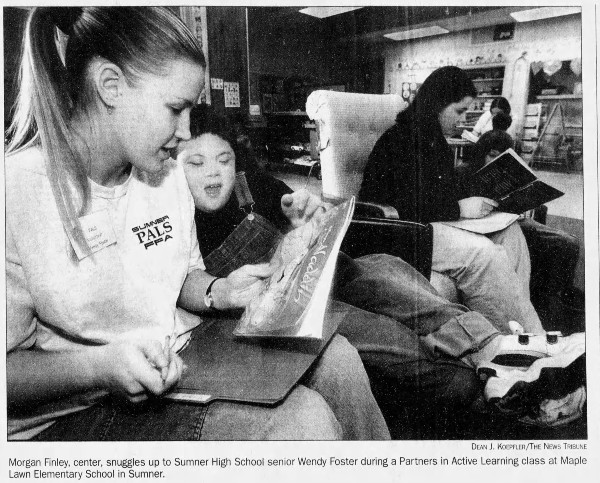In the previous Friday Footnote we looked at newspaper articles published about FFA chapter libraries between 1930 and 1959. During this time span having a FFA chapter library was in the National FFA Program of Work. There were numerous newspaper articles about FFA libraries during this time span.
The National FFA Program of Work after 1960 made no mention of FFA libraries and the national FFA no longer reported on the number of FFA libraries. So the question is “Did newspapers publish articles about FFA libraries after 1960?” The answer is yes at first but over time the number of articles decline precipitously.
In this Footnote we will explore how the articles in newspaper about FFA libraries remained the same or changed?
Newspaper Articles from the 1960s
Louisiana – On Monday, July 24 three Entomologists from the LSU Experiment Station presented a program to members of the Bunkie FFA…the group went over to the Newton cotton fields where they were shown how to make cotton insect counts…At the end of the field trip many bulletins on insect control were distributed to the members for the FFA home libraries. – The Weekly News, Marksville, July 27, 1961.
Missouri – Donald Baker of the Springfield FFA was the winner of the Springfield Chamber of Commerce best home FFA library Award. – Springfield Leader and Press. March 10, 1963
Kentucky – The Simpson County Soil and Water Conservation District “furnished conservation books for the FFA Library” at Franklin-Simpson High School. – The Franklin Favorite, September 21, 1967. The same statement was made in similar articles over the years about the Soil and Water Conservation District.
Texas – “Plans Laid for District FFA Film Library” was the news article heading in the Hamlin Herald (July 14,1960). The first sentence in the article reads “Vocational agriculture teachers and representatives of Future Farmers of America chapters in the Stamford District met in Stamford Tuesday to formulate plans for a revolving film library for the district.”
Alabama – It appears FFA chapters were still starting chapter libraries in the 1960s. The Alexander City Outlook, May 3, 1962 carried the article below.

Figure 1. Article from the Alexander City Outlook, May 3, 1962
Newspaper Articles from the 1970s to 2022 (note the time span)
The number of articles appearing in newspapers about FFA libraries decline dramatically from the 1970s on. However, there was a shift in emphasis in the FFA as it relates to reading starting in the 1990s. The impetus for this change was Project PALS. More about PALS shortly.
Washington – Supt. Roy Dennis, who will retire to a small acreage at the end of the year, was presented a sheaf of how-to-do-it material from the [Kelso High School] FFA library. – Longview Daily News, April 28, 1972
Texas – Figure 2. From the Childress Index, February 18, 1975

Illinois -…the FFA headquarters [in Alexandria, Virginia] have been expanded to include the FFA National Hall of Achievement, which was funded through donations from agri-business. The new exhibit area cost $250,000 and features museum-quality exhibits and audio-visual presentations on nine major themes. A modern FFA library donated by Deere & Co., houses information pertinent to agriculture and the FFA. – The Dispatch, Moline, May 6, 1982 [Curator’s Question – Who knows what happened to the “modern FFA Library” at the FFA center in Alexandria when the Center moved to Indianapolis? I do.]
Iowa – Students are dropping their books and turning to a computer screen to learn the latest developments in agriculture. They’re doing so with the aid of AgEd Network… Michelle Munderloh, agriculture teacher at Benton Community High School, has been use AgEd for less than a month, but she already sees its benefits…Her students also access the [online] FFA library and read about FFA conventions, scholarships and marketing contests. – The Gazette, Cedar Rapids, November 28, 1994
Wyoming – The column heading was “EnCana funds FFA library, scholarships.” The story – The Wyoming Future Farmers of America Foundation has received a $15,000 challenge grant from EnCana Oil & Gas. The Grant will be used to provide scholarships to FFA members who plan to enroll in the University of Wyoming’s Reclamation and Restoration Center. The money will also help initiate a consistent agriculture curriculum resource library. – The Billings Gazette, November 29, 2009.
Tennessee – “FFA Looking to Harvest Literacy with new program” was the headline for an article in The Tennessean, September 28, 2005. The article starts “The Tennessee Association of Future Farmers of America knows it students know about plows. But do they know PLOW? The acronym stands for Passing Literacy OnWard – and its aim is to have students plow through books. As in, reading.” Near the end of the article we find “The students have also started a FFA chapter library and have a bulletin board to chart their progress…’They are doing all this on their own,’ [Spring Hill] FFA chapter adviser Gwynne Evans said. ‘I just get out of their way.’”
So what was the PLOW program and how did it operate? A future Friday Footnote will be devoted exclusively to the PLOW program.
Project PALS
In 1991 the National FFA initiated a pilot project known as Project PALS. This was the start of a three year pilot study involving nearly 200 schools. The initial program was to match a high school student (the mentor) with an elementary school student (the mentee). These two individuals worked together on agricultural activities, recreation, and mentoring (including reading).
This program was launched through a grant that exceeded $1 million dollars from the W. K. Kellogg Foundation. According to FFA New Horizons (1991, p. 7) “The Foundation picked FFA for this project because of its reputation for community involvement.”
Michigan and Arkansas were the first two states to pilot the program. Then other states were added. FFA members who were chosen to be mentors went through a special Made for Excellence leadership training seminar. The project director, Josie F. Garza, said this type of program was common in city schools but rare in rural areas. Garza hoped the program would take on a life of its own after three years. And it did.
The PALS (Partners in Active Learning Support) program has matured and does make a difference in the lives of both the mentor and mentee. Mark Zimmerman, the agriculture teacher at Spencer High School in Wisconsin stated (1996, p. 4) “I feel that PALS is possibly the best thing I have accomplished…PALS provides the opportunity for ordinary high school students to do something really extraordinary.”
Let’s take a quick sampling of newspaper articles about PALS.
Florida – Twenty High School students are about to learn if [they] can boost the low math and reading scores of 40 elementary students. Jodi Geiger, New Smyrna Beach High School agriculture teacher and FFA advisor met with her FFA members last summer and decided to work with elementary school students. However, they did not hear about Project PALS until a national FFA convention in the fall. “We found out they were describing something we wanted to do,” she said. The program will provide role models for the younger students and give the older students a chance to teach. All of the elementary students have scored low on reading and math skills test. This was the pilot program for PALS in Florida. – The Orlando Sentinel, February 16, 1992.
Iowa – The Maple Valley FFA chapter is taking part in Project PALS, a mentoring program that matches high school agriculture students with selected elementary students… Twelve high school students in Dennis Benson’s natural resource class were paired with selected second-grade students…Each Friday morning for one hour Project Pals meet to work on project or activity for the week…Some time is spent in reading or math, as well. Sioux City Journal, January 6, 1994.
Washington – Students leap out of their seats when Wendy Foster comes by. It happens every week at Sumner’s Maple Lawn Elementary School, where Foster, a Sumner High School senior, reads to children with special education needs. “They’re pals. They’re buddies” remarked teacher Pat Cughan. That’s the goal of Partners in Active Learning Support, or PALS, which links high school students with elementary school students who need one-on-one assistance. “We just go in and help them out whether it is with math or reading” said Foster who leads Sumner’s PALS group. Forty-three Sumner High School students work with the PALS program. Initially PALS operated only at Maple Lawn Elementary School, but this year, high schoolers go to other elementaries. They provide their own transportation.
Ashley Haugen, another Sumner High School senior, said its rewarding to watch the elementary students learn and know you’re making a difference. Matthew Campeggio, 11, is especially enthusiastic about his sessions with Haugen. “He always asks me if it is reader day to-day?” Cughan said. PALS helps even nonreaders because it boosts listening skills and improves the ability to sit and pay attention according to Cughan.- The News Tribune, Tacoma. February 24, 1999.

Figure 3. Photo from the Tacoma News Tribune. February 24, 1999.
Wisconsin – The heading for the article reads “PALS: FFAers give third-graders a boost”. Here are excerpts from the article “In December, the New Holstein FFA chapter started a program called PALS. That stands for Partners in Active Learning. As we face the world today, there are many kids who have problems reading, doing math and other subjects. Also, there are some kids who need that older person to talk to or just to have someone to look up to and hang out with. That is what PALS is for…FFA members go over to the elementary school and help out with the third graders. So far, the program has gone very well. We have helped them with math, reading, and doing different projects…It not only benefits them, but also the FFA members. Fond Du Lac Commonwealth Reporter, February 17, 2002.
Many more articles about PALS could be featured but you get the idea. It is still a viable program today.
Concluding Remarks
By looking at the newspaper article published after 1960 there are some discernable trends at it relates to FFA libraries and reading. In the 1960s many FFA chapters continued to promote having a library. But there were mentions of films being added to the library. Then the AgEd Network appeared on the scene followed by other computer driven reading resources. Students switched from reading physical books to online reading.
When Project PALS was launched in the early 1990s there was a renewed emphasis on reading, but it was FFA members helping elementary students to read.
No matter how you slice it, reading is an important skill we need to promote in all students. What are you doing to promote reading with your students?
In upcoming Footnotes we will learn more about PLOW, improving reading literacy, and will even examine some of the early agricultural education/FFA focused books that first generation FFA members were reading. Stay tuned.
References
Egan, Greg; Arkfeld, Tim; Vanderweken, Vance, & Zimmerman, Mark. (1996). PALS (Partners in Active Learning Support). The Agricultural Education Magazine. February 1996. Volume 68, Number 8.
Project Pals. FFA New Horizons, June-July 1991, Volume 39, Issue 5,
The National FFA has numerous teaching resources for PALS at https://ffa.app.box.com/s/f94quldigzrqeavry0cxdtv55n4ml0g3. The PALS Handbook for the FFA advisors can be accessed at https://ffa.app.box.com/s/f94quldigzrqeavry0cxdtv55n4ml0g3/file/303872087908.
